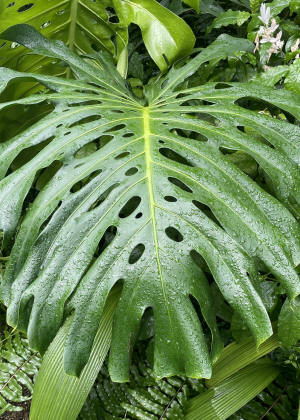|
 2025
is The Year of The Monstera 2025
is The Year of The Monstera
By Melinda Myers
 Send a link to a friend
Send a link to a friend
[January 04, 2025]
Kick-off 2025 with the addition of a monstera
plant to your indoor garden. You’ll join other gardeners observing
2025 as the Year of the Monstera. Each year, the National Garden
Bureau (NGB) selects and celebrates one plant in each of the
following categories: annual, perennial, bulb, edible, and shrub.
The plants are chosen for their popularity, easy-care nature,
adaptability, diversity, and versatility.
Monstera certainly meets the criteria and as NGB declared it is “the
world’s most iconic indoor plant.” The large, glossy heart-shaped
leaves have distinct perforations called fenestrations. Scientists
speculate these holes allow tropical downpours to pass through,
minimizing plant damage. |
|
 There
are several different monsteras, ranging in size and leaf shape
including some with variegated leaves. Some are easy to grow while
others are a bit fussier. Always check the plant label for specifics
on caring for the monstera you select. There
are several different monsteras, ranging in size and leaf shape
including some with variegated leaves. Some are easy to grow while
others are a bit fussier. Always check the plant label for specifics
on caring for the monstera you select.
One of the most popular and readily available is the Monstera
deliciosa, commonly called split-leaf philodendron, even though it
is not a philodendron. It’s known for its large heart-shaped
perforated leaves on thick stems. In its native habitat, it can grow
66 feet tall but typically grows up to 7 or 8 feet indoors. The
flowers that seldom appear indoors are like a peace lily with a
cone-shaped structure (spadix) surrounded by a cupped white sheath (spathe).
The flowers may be followed by an edible fruit that tastes like a
combination of pineapple, banana, and mango. This flavorful
combination inspired its nickname, fruit salad plant, and the
botanical name that translates to delicious monstrosity.
In general, these tropical beauties prefer growing conditions like
that of their native habitat. They prefer bright, filtered indirect
sunlight. Avoid direct sunlight that can scorch or cause leaves to
turn yellow. Grow monsteras in a quality well-drained potting mix in
a container with drainage holes. Water them thoroughly when the top
two inches of soil are dry. Pour off excess water or place the pot
on pebbles in a saucer. The pebbles elevate the pot above any water
that collects in the saucer to avoid root rot. As this water
evaporates, humidity increases around the plant.
Further boost the humidity by placing your monstera
with other plants. As one plant loses moisture or transpires, the
neighboring plants will benefit.
[to top of second column] |

Only apply houseplant fertilizer when the plants are
actively growing, usually March through October. Let the plant and
your garden goals be your fertilization guide. Fertilizers provide
needed nutrients to plants in need of a nutrient boost or when you
want to stimulate more growth.
Support the plant with a moss pole or trellis as it starts to climb.
The large aerial roots attach to nearby surfaces to help them climb.
In nature, these roots help monsteras to climb trees and have been
used to make rope in Peru and baskets in Mexico.
Melinda Myers has written over 20 gardening books,
including Midwest Gardener’s Handbook, 2nd Edition and Small Space
Gardening. She hosts The Great Courses “How to Grow Anything”
instant video and DVD series and the nationally syndicated Melinda’s
Garden Moment radio program. Myers is a columnist and contributing
editor for Birds & Blooms magazine. Myers’ website is
www.MelindaMyers.com.
[Photo courtesy of MelindaMyers.com]
 |